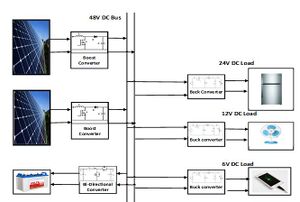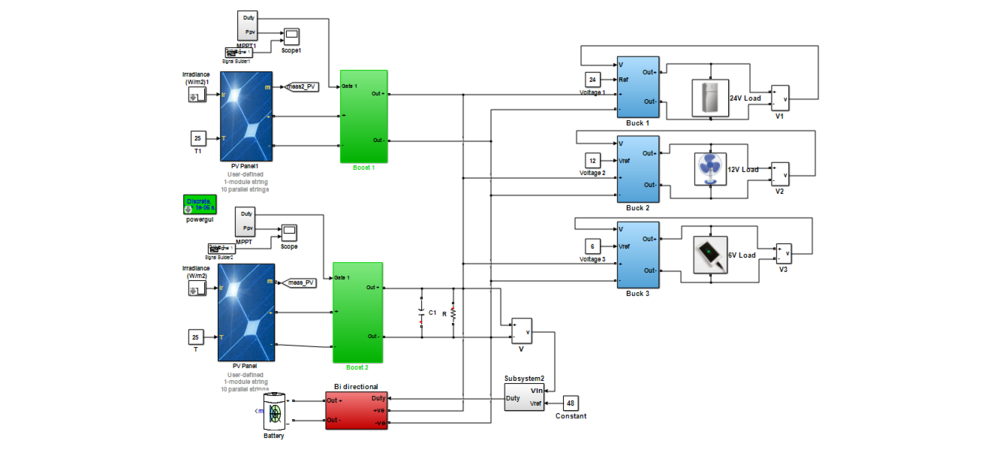DC Nano Grid:[edit | edit source]
There has been seen continuous search for alternative sources to generate adequate electrical power in Bangladesh, yet some areas of the country still don’t have access to it. Solar DC Nano grid can be a possible approach towards achieving electrification to certain areas where grid connectivity is still unavailable. It can generate and distribute power to a cluster of households at close proximity reliably. This research paper proposes a model of DC Nano grid integrated with solar PV module which can supply electricity to up to 20 households at a distance of about 1 km. This article provides simulation results of buck converters assigned to supply power at three different voltage levels to feed various domestic loads. Along with this, cost estimation is presented of the proposed model which motivates the implementation of the Nano grid.
Keywords— Photovoltaic (PV), Solar DC Nano grid, Maximum power point tracking (MPPT), Buck Converters.
Modeling of Solar DC Nano Grid[edit | edit source]
A. Concept:[edit | edit source]

The diagram of the DC Nano grid connected with solar PV module is shown in fig. 1. This DC Nano grid is using solar PV modules of different ratings. The complete structure includes MPPT, DC/DC converter, connected DC loads and battery. For extracting maximum power from the PV array, maximum power point tracking (MPPT) is implemented. The different units of the Nano grid such as solar panels, energy storage units are linked with a common DC bus using different converters. These converters regulate the voltages at DC bus to a constant value of 48 V. In the subsequent stage, three different buck converters are used to supply loads at voltage levels: 6 V, 12 V & 24 V.

B. Nano Grid Model:[edit | edit source]
Fig. 2 depicts the pictorial representation of a Nano grid. In this system, a basic installation of a PV panel of around 4-5 kW is done at a conventional location. Battery storage is placed closed to ensure continuous power supply.
C. Concept household[edit | edit source]

One major thing that is observed that most of the household loads in rural areas can operate on DC voltage. All these DC loads can operate at 3 different voltage levels. Fig.3 shows the layout of power consumption in a single household. The lights, fans and television are connected to 12 V power line, the refrigerator and water pump are connected to 24 V power line and the mobile phones are charged on the 6 V power line.
Simulink Modeling[edit | edit source]

Conclusion:[edit | edit source]
The scarcity of energy in Bangladesh is mainly due to the dependency of its power generation on imported fossil fuel and natural gas. Several private and government organizations have taken multiple initiatives to move towards renewable electricity production sufficient amount. DC solar Nano grid may be the efficient solution to our power generation shortage problem. It can be deployed to meet the power demand of the rural area of Bangladesh. The modeling of the DC Nano grid is done by using MATLAB Simulink. Again the DC bus voltage is maintained constant using closed-loop PI controllers and loads are supplied at 3 different voltage levels at the consumer premises. Also, an analytical study is done on the per unit cost of energy of the DC Nano grid. The study demonstrated that by using the DC Nano grid, the cost of electricity will be reduced significantly as the per-unit cost is around 4 TK. However, the shortcomings of the DC Nano grid are that this Nano grid system is designed only for a particular number of houses and an energy backup system is required to be included in the system in case of bad weather.
References:[edit | edit source]
[1] Taif Hossain Rocky, Rafiul Islam, Uttam Kumar Saha, ‘‘Nano solar grid (NSG): A solution for rural market power crisis,’’ in 2nd International Conference on Green Energy and Technology, Dhaka, Bangladesh, 5-6 September 2014, pp. 14-17.
[2] M. Rezwan Khan, Edward D. Brown, “DC nanogrids: A low cost PV based solution for livelihood enhancement for rural Bangladesh,” in 3rd International Conference on the Developments in Renewable Energy Technology (ICDRET), Dhaka, Bangladesh, 29-31 May 2014, pp. 1 – 5.
[3] M. Mahmudul Hasan Sajeeb, Aminur Rahman, ‘‘Feasibility analysis of solar DC Nano grid for off grid rural Bangladesh,’’ in 2015 3rd International Conference on Green Energy and Technology (ICGET), Dhaka, Bangladesh, 11-12 September,2015, pp. 3 – 7.
[4] Periyasamy Muthuvel, S. Arul Daniel, Sajal K. Paul, “Sizing of PV array in a DC nano-grid for isolated households after alteration in time of consumption,” in International Conference on Smart grids, Power and Advanced Control Engineering (ICSPACE), Bangalore, India, 17-19 Aug. 2017, pp. 1632-1641
[5] Rajesh M Pindoriya, N. M. Pindoriya, S. Rajendran , “Simulation of DC/DC converter for DC nano-grid integrated with solar PV generation,” in IEEE Innovative Smart Grid Technologies - Asia (ISGT-ASIA), Bangkok, Thailand, 3-6 Nov. 2015, pp. 1–6.
[6] Mohammed Azharuddin Shamshuddin,Sudhakar Babu Thanikanti, Vigna.K, Ralph Kennel, ‘‘Implementation and design of an autonomous residential DC nanogrid,’’ in 2019 International Exhibition and Conference for Power Electronics, Intelligent Motion, Renewable Energy and Energy Management , Nuremberg, Germany, 7-9 May 2019.
[7] G. Manavalan, H. M. Tania, Jagadish Kumar Patra, S. Prema, “A closed loop system to stabilize a 24V solar DC nano grid,” in International Conference on Smart grids, Power and Advanced Control Engineering (ICSPACE), Bangalore, India, 17-19 Aug. 2017, pp. 177 – 182.
[8] Mahmud Ibrahim, Mohammud Nurul Huda, M. Rezwan Khan, ‘‘A smart solution for solar DC nano grid integrated with pre-paid billing and mobile application,’’ in 2016 3rd International Conference on Electrical Engineering and Information Communication Technology (ICEEICT), Dhaka, Bangladesh ,22-24 Sept. 2016, pp. 17 – 21.
[9] K. Ramya, D. Vennila, P. Rajapriyan,‘‘Design and Implementation of Low Power Nanogrid with Intelligent Solar PV Utilization,’’ in 2019 1st International Conference on Innovations in Information and Communication Technology (ICIICT), Chennai, India, 25-26 April 2019
[10] Bangladesh Energy Situation, Energypedia [Online]. Available: https://energypedia.info/wiki/Bangladesh_Energy_Situation, Accessed on: August 30, 2020.
[11] Grid Emission Factor (GEF) for Bangladesh [Online]. Available: http://www.doe.gov.bd/sites/default/files/files/doe.portal.gov.bd/notices/d89105eb_549d_4b79_bd4c_6f24e24b037d/1.%20Grid%20Emission%20Factor%20(GEF)%20for%20Bangladesh.pdf. Accessed on: June 16, 2021.